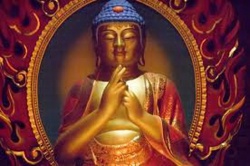32 Signs of a Great Man
The 32 Signs of a Great Man (mahā purisa lakkhaṇa) are auspicious marks that are supposed to be present on the bodies of all Buddhas. Although only incidental to Buddhism, this idea is the theme of three discourses (D.II,142; M.II,133; Sn.103) and is mentioned briefly in several others. The idea of the Signs probably had its origins in Brahmanism and was incorporated into Buddhism at a later period for reasons that are not clear. Some of the Signs, like the long tongue, the blue eyes, the golden complexion and the ensheathed penis, were probably connected with the ancient Indian concept of idealized physical beauty. Others are so strange, grotesque even, that it is difficult to know what to make of them. It is very clear from the Tipiṭaka that the Buddha’s physical appearance was normal in every way. When King Ajātasattu went to meet the Buddha, he was unable to distinguish him from the surrounding monks (D.I,50). If the Buddha had any of the 32 Signs, the king would have recognized him immediately. Pukkasāti sat talking to the Buddha for hours before realizing who he was (M.III,238). If the Buddha had any of the Signs, the young man would have soon noticed it and known that he was someone unusual. When Upaka encountered the Buddha walking along the road to Gaya, the thing he noticed most about him was ‘clear faculties and radiant complexion’ (M.I,170). He did not mention seeing any of the 32 Signs. In the Buddha’s teachings, the external and the physical are always subordinate to the internal and the psychological (S.I,169). The Buddha was aware of the Brahmanical concept that a ‘great man’ could be known by his physical characteristics, and he rejected this notion. Someone once asked him: ‘They talk about a “great man,” a “great man.” But what is it that makes a great man?’ The Buddha replied: ‘It is by freeing the mind that someone becomes a great man. Without freeing the mind one cannot be a great man.’ (S.V,157).
The Concept of Great Man, B.Wimalaratana, no date.
